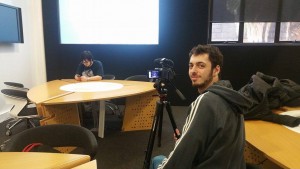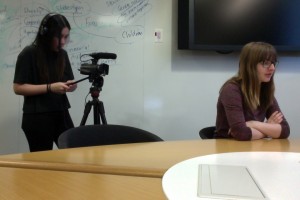“The Katering Show” is an excellent parody of your average how-to shows, as Lenny Ann Low (2016) has said. The show is about “The journey of a food intolerant, and an intolerable foodie” as they go about teaching their audience about how to cook fructose-free dishes mixed in with whatever food-fads exist, from paleo-eating to eating a lasagna made from their own placenta to, in season 1 episode 2, ethical eating.
Low (2016) goes on about how Kate McCartney’s uninterested; staring-into-space attitude is hilarious, especially when working off of Kate McLennan’s overly enthusiastic performance. As such, they perfectly show the incredible cheeriness of the cooking show genre, while making fun of it every step of the way. They swear, insult people, answer lewd fan mail that includes “I want to f*** you in the face”, and makes repeated fun of the very food fad they are attempting to replicate. In the “ethical eating” episode, the Kate’s say something along the lines of “for those of us who can’t afford to have principles…” which is quite amusing. They also in the same episode claim they will eat kangaroo rather than wallaby or possum due to the cuteness of the latter two animals, which is a nice little joke on what specific animals we are okay with eating as a culture.
Williams, D (2012) claims that a comedy webs series usually becomes successful because of how different they are to traditional television programs, using mediocre equipment, choppy editing, all alongside over-the-top acting. While “The Katering Show” certainly has over-the-top acting (especially from Kate McLennan), it definitely has a fairly decent production value. Its cinematography is good, and its editing is done similarly to a normal cooking show so as to emphasize its parody of the genre.
Speaking of the editing, there is a strong use of close-ups on the food, the various ingredients, and cooking utensils. Usually there is a non-diegetic narration by one of the Kate’s during these shots. John Rosenberg (2011) claims that this editing can help create a set-up and punch line for jokes. He goes on to say how the use of “coverage” gives the editor the ability to cut away to other characters (or, in the case of “The Katering Show”, the other Kate) or to arrive quicker to a particular punch line. As I mentioned earlier about the web-series, the editing is done with the intention of giving focus to what the characters are saying and doing so as to look more like a typical cooking show. The set-ups are generally what they will cook with or how they are cooking it, and the punchline is usually the reaction they have when talking about it (an example being “the highest source of iron is human blood, but we will be using meat”).
While only one of the resources actually talks about “The Katering Show” in-depth, the other readings were somewhat useful in looking at what a web-series generally does and looks like. “The Katering Show”, however, seems to not follow a typical web-series format, with its good cinematography, editing, and being informative when it comes to cooking. It does, though, have the amusing over-the-top acting that seems prevalent in a web-series.
References:
- Williams, D 2012, Web TV Series: How to Make and Market them. “Utilising the Web.” Harpenden: Creative Essentials, Kamera Books. P29
- Low, Ann Lenny 2016, “TV Review: The Katering show – a new recipe for comedy”, The Sydney Morning Herald, 10th June, viewed 4th August 2016, http://www.smh.com.au/entertainment/tv-and-radio/tv-review-the-katering-show–a-new-recipe-for-comedy-20160607-gpd9od.html
- Rosenberg, John. Chapter 7 – Genre Editing Styles II. “The Healthy Edit.” Focal Press, Boston 201 p.69



